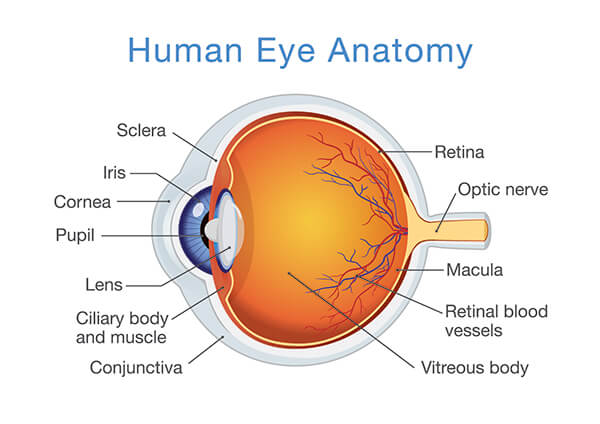How our eyes work
There are a few components to how our eyes work.
- The cornea is the clear window into the eye, responsible for 2/3 of the focussing power. It prevents germs, dust, and irritants from entering your eye. It relies on tears and fluid inside the eye for oxygen, nourishment and hydration.
- The iris (coloured part of your eye) is like the shutter in a camera, regulating the amount of light that can enter the eye.
- The lens sits behind the iris, and makes up 1/3 of the focussing strength of the eye. Between birth and middle age, it has the ability to bring objects up close into focus.
- The retina is the film in the camera of the eye, sensing light and turning it into an electrical signal.
Vision results from light rays bending or refracting as they pass through your cornea and lens.
The shape and length of your eye determine how well your vision can focus. In a normal eye, light rays are focussed onto the retina, which sends signals through the optic nerve to your brain, where they are interpreted as images.
Refractive errors
When the cornea’s curvature doesn’t match the length of the eye, the light rays cannot focus properly on the retina.
This is why vision becomes distorted as refractive errors arise, such as myopia, hyperopia and astigmatism – which you can have a combination of, such as myopia and astigmatism or hyperopia and astigmatism.
Refractive procedures fix the 3 refractive errors below by changing the shape of the cornea or by adding a permanent lens to improve focus.
Myopia
Or near-sightedness. Close-up objects are seen clearly, while distant objects appear blurry. With this condition, you most likely need glasses for distance vision.
Learn more
Hyperopia
Or long-sightedness. Distant objects are seen clearly, while close-up objects appear blurry. With this condition, you most likely need glasses for near vision.
Learn more
Astigmatism
Both close and distant objects appear blurry.
Learn more
Other vision impairments
In addition to refractive errors, below are some other eye conditions.
Presbyopia
The loss of ability to focus on nearby objects, such as reading. This usually occurs around age 40 and over, with most people symptomatic between 45 to 55.
Learn more
Cataracts
The loss of clarity with cloudy areas.
Learn more
Dry eye syndrome
Irritated eyes due to insufficient moisture.
Learn more
Keratoconus
Distorted vision due to an irregularly-shaped cornea that appears to bulge out from the eye socket.
Learn more



